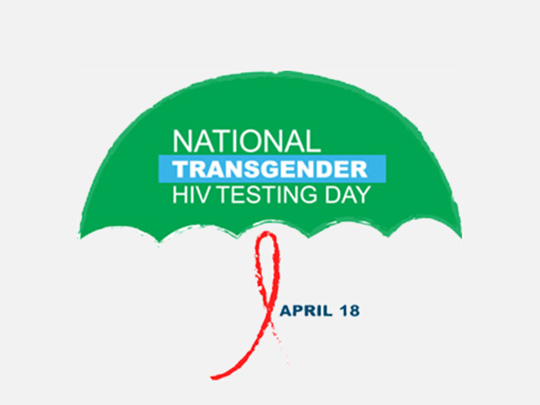Dear Colleague: CDC Observes National Transgender HIV Testing Day 2018
Topics
Dear Colleague: CDC Observes National Transgender HIV Testing Day 2018 Audio Narration

Cross-posted from NCHHSTP Communications Center
Dear Colleague,
April 17, 2018
Please join the Centers for Disease Control and Prevention (CDC) tomorrow as we observe National Transgender HIV Testing Day, sponsored by the Center of Excellence for Transgender HealthExit Disclaimer at the University of California, San Francisco. This day is an opportunity for transgender people to get tested for HIV and know their status, and to promote HIV prevention and treatment efforts.
Transgender women in the United States are at high risk for acquiring HIV. According to current estimates, around a quarter (22-28%) of transgender women are living with HIV, and more than half (an estimated 56%) of black/African American transgender women are living with HIV. Though data about transgender men are limited, transgender men who have sex with men may also be at high risk for HIV.
HIV testing is the first step for people living with HIV to begin treatment, which can keep them healthy. The sooner people living with HIV learn their status and start treatment, the more they benefit. Treatment can also help prevent transmission to others: people living with HIV who take their HIV medicine as prescribed and achieve and maintain viral suppression have effectively no risk of transmitting HIV to HIV-negative sexual partners. For people who are HIV-negative, testing can be a gateway to prevention tools and strategies that can protect them from HIV, like pre-exposure prophylaxis (PrEP) and other prevention services. Yet evidence suggests that HIV testing rates are low among transgender people. Culturally appropriate, focused HIV testing efforts are needed to increase testing in transgender communities.
CDC is working with partners to expand the reach of HIV testing, prevention, and treatment services for transgender people and to address the cultural and socioeconomic factors that place many at increased risk for HIV. Stigma and discrimination, lack of adequate employment or housing, and lack of understanding in health care systems about the needs of transgender people, for example, may keep many from accessing HIV services that could protect them and their partners. Removing these barriers is crucial to making progress toward ending new HIV infections among transgender people.
Some of CDC’s HIV prevention activities that focus on transgender populations include:
- Capacity building assistance to implement HIV prevention strategies and strengthen the infrastructure of health departments, community-based organizations, and clinics that serve transgender people.
- Funding to expand HIV testing of young transgender persons of color in community-based organizations.
- Project PrIDE, which supports health departments’ efforts to implement PrEP and data-to-care projects for transgender women.
- Research to evaluate the effectiveness of programs and assess the needs of providers and transgender patients.
Collaborating with jurisdictions to improve data collection on HIV among transgender people, which could lead to more effective public health actions. - Act Against AIDS communication materials to reach transgender people. All Act Against AIDS consumer-focused campaigns, including Doing It, Start Talking. Stop HIV., and HIV Treatment Works, include resources featuring transgender people.
- A new continuing medical education opportunityExit Disclaimer that assists health care providers in delivering patient-centered HIV prevention and care to transgender people.
Tomorrow is a day of action for all of us. Thank you for joining together in this important work.
Sincerely,
/Eugene McCray/
Eugene McCray, MD
Director
Division of HIV/AIDS Prevention
National Center for HIV/AIDS, Viral Hepatitis, STD, and TB Prevention
Centers for Disease Control and Prevention
www.cdc.gov/hiv
/Jonathan Mermin/
Jonathan H. Mermin, M.D., MPH
RADM and Assistant Surgeon General, USPHS
Director
National Center for HIV/AIDS, Viral Hepatitis, STD, and TB Prevention
Centers for Disease Control and Prevention
www.cdc.gov/nchhstp